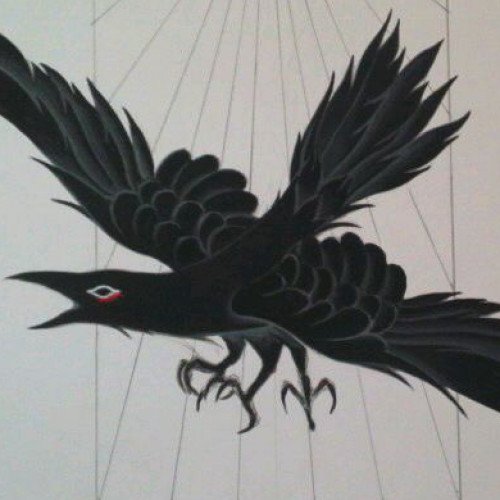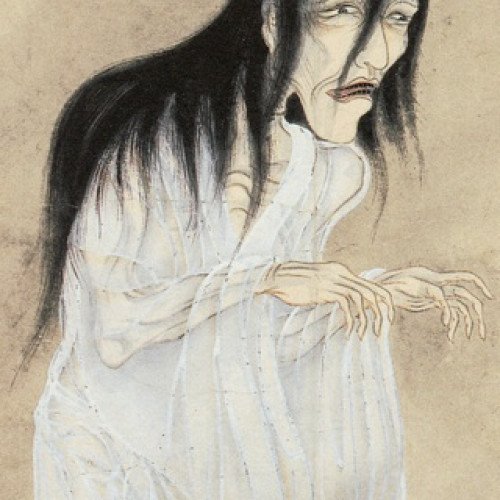Yatagarasu VS Ghost

Yatagarasu
In Japanese mythology, this flying creature is a raven or a jungle crow called Yatagarasu (八咫烏, "eight-span crow")[16] and the appearance of the great bird is construed as evidence of the will of Heaven or divine intervention in human affairs.[17] Although Yatagarasu is mentioned in a number of places in Shintō, the depictions are primarily seen on Edo wood art, dating back to the early 1800s wood-art era. Although not as celebrated today, the crow is a mark of rebirth and rejuvenation; the animal that has historically cleaned up after great battles symbolized the renaissance after such tragedy. Yatagarasu as a crow-god is a symbol specifically of guidance. This great crow was sent from heaven as a guide for legendary Emperor Jimmu on his initial journey from the region which would become Kumano to what would become Yamato, (Yoshino and then Kashihara). It is generally accepted that Yatagarasu is an incarnation of Taketsunimi no mikoto, but none of the early surviving documentary records are quite so specific.[18] In more than one instance, Yatagarasu appears as a three legged crow not in Kojiki but in Wamyō Ruijushō. Both the Japan Football Association and subsequently its administered teams such as the Japan national football team use the symbol of Yatagarasu in their emblems and badges respectively.[19] The winner of the Emperor's Cup is also given the honor of wearing the Yatagarasu emblem the following season. Although the Yatagarasu is commonly perceived as a three-legged crow, there is in fact no mention of it being such in the original Kojiki. Consequently, it is theorised that this is a result of a later possible misinterpretation during the Heian period that the Yatagarasu and the Chinese Yangwu refer to an identical entity.
Statistics for this Xoptio

Ghost
In folklore, a ghost is the soul or spirit of a dead person or animal that can appear to the living. In ghostlore, descriptions of ghosts vary widely from an invisible presence to translucent or barely visible wispy shapes, to realistic, lifelike forms. The deliberate attempt to contact the spirit of a deceased person is known as necromancy, or in spiritism as a séance. Other terms associated with it are apparition, haunt, phantom, poltergeist, shade, specter or spectre, spirit, spook, and wraith. The belief in the existence of an afterlife, as well as manifestations of the spirits of the dead, is widespread, dating back to animism or ancestor worship in pre-literate cultures. Certain religious practices—funeral rites, exorcisms, and some practices of spiritualism and ritual magic—are specifically designed to rest the spirits of the dead. Ghosts are generally described as solitary, human-like essences, though stories of ghostly armies and the ghosts of animals rather than humans have also been recounted. They are believed to haunt particular locations, objects, or people they were associated with in life. According to a 2009 study by the Pew Research Center, 18% of Americans say they have seen a ghost.The overwhelming consensus of science is that there is no proof that ghosts exist. Their existence is impossible to falsify, and ghost hunting has been classified as pseudoscience. Despite centuries of investigation, there is no scientific evidence that any location is inhabited by spirits of the dead. Historically, certain toxic and psychoactive plants (such as datura and hyoscyamus niger), whose use has long been associated with necromancy and the underworld, have been shown to contain anticholinergic compounds that are pharmacologically linked to dementia (specifically DLB) as well as histological patterns of neurodegeneration. Recent research has indicated that ghost sightings may be related to degenerative brain diseases such as Alzheimer's disease. Common prescription medication and over-the-counter drugs (such as sleep aids) may also, in rare instances, cause ghost-like hallucinations, particularly zolpidem and diphenhydramine. Older reports linked carbon monoxide poisoning to ghost-like hallucinations.In folklore studies, ghosts fall within the motif index designation E200-E599 ("Ghosts and other revenants").